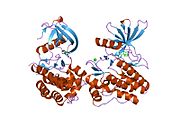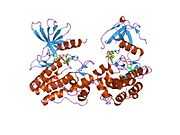TNK2
| edit |
| Tirozinska kinaza, nereceptor, 2 | |||||||||||
|---|---|---|---|---|---|---|---|---|---|---|---|
 PDB prikaz baziran na 1cf4. | |||||||||||
| Dostupne strukture | |||||||||||
| 1CF4, 1U46, 1U4D, 1U54, 3EQP, 3EQR, 4EWH, 4HZR, 4HZS, 4ID7 | |||||||||||
| Identifikatori | |||||||||||
| Simboli | TNK2; ACK; ACK-1; ACK1; p21cdc42Hs | ||||||||||
| Vanjski ID | OMIM: 606994 MGI: 1858308 HomoloGene: 4224 GeneCards: TNK2 Gene | ||||||||||
| EC broj | 2.7.11.1 2.7.10.2, 2.7.11.1 | ||||||||||
| |||||||||||
| Pregled RNK izražavanja | |||||||||||
 | |||||||||||
 | |||||||||||
| podaci | |||||||||||
| Ortolozi | |||||||||||
| Vrsta | Čovek | Miš | |||||||||
| Entrez | 10188 | 51789 | |||||||||
| Ensembl | ENSG00000061938 | ENSMUSG00000022791 | |||||||||
| UniProt | Q07912 | O54967 | |||||||||
| Ref. Sekv. (iRNK) | NM_001010938 | NM_001110147 | |||||||||
| Ref. Sekv. (protein) | NP_001010938 | NP_001103617 | |||||||||
| Lokacija (UCSC) | Chr 3: 195.59 - 195.64 Mb | Chr 16: 32.64 - 32.68 Mb | |||||||||
| PubMed pretraga | [1] | [2] | |||||||||
Aktivirana CDC42 kinaza 1, takođe poznata kao ACK1, je enzim koji je kod ljudi kodiran TNK2 genom.[1][2][3][4][5]
TNK2 gen kodira nereceptorsku tirozinsku kinazu, ACK1, koja se vezuje za višestruke receptorske tirozinske kinaze e.g. EGFR, MERTK, AXL, HER2 i insulinski receptor (IR). ACK1 takođe interaguje sa Cdc42Hs u njegovoj GTP-vezanoj formi i inhibira intrinzičnu i GTPaznu aktivnost Cdc42H. Vezivanje je posredovano jedistvenom sekvencom od 47 aminokiselina između C-terminusa i SH3 domena. Ovaj protein učestvuje u regulatornom mehanizmu kojim se održava GTP-vezana aktivna forma Cdc42H i koji je direktno povezan sa torozinsko fosforilacionim putem prenosa signala. Poznato je nekoliko alternativno splajsovanih transkriptnih varijanti ovog gena, ali se izražavaju samo dve varijante.[5]
Interakcije[uredi | uredi kod]
ACK1 ili TNK2 formira interakcije sa AKT,[3] Androgenskim receptorom ili AR,[6] tumornim supresorom WWOX,[7] FYN[8] i Grb2.[9][10] ACK1 interakcije sa njegovim supstratima dovode do njihove fosforilacije na specifičnim tirozinskim ostacima. ACK1 direktno fosforiliše AKT na tirozinu 176, AR na tirosizinima 267 i 363, i WWOX na torozinu 287. Ack1-AR signalizacije takođe učestvuje u regulaciji ATM nivoaa[11]
Reference[uredi | uredi kod]
- ↑ Mahajan K, Mahajan NP (August 2010). „Shepherding AKT and androgen receptor by Ack1 tyrosine kinase.”. J Cell Physiol. 224 (2): 327–23. DOI:10.1002/jcp.22162. PMID 20432460.
- ↑ Manser E, Leung T, Salihuddin H, Tan L, Lim L (June 1993). „A non-receptor tyrosine kinase that inhibits the GTPase activity of p21cdc42”. Nature 363 (6427): 364–7. DOI:10.1038/363364a0. PMID 8497321.
- ↑ 3,0 3,1 Mahajan K, Coppola D, Challa S, Fang B, Chen YA, Zhu W, Lopez AS, Koomen J, Engelman RW, Rivera C, Muraoka-Cook RS, Cheng JQ, Schönbrunn E, Sebti SM, Earp HS, Mahajan NP. (March 2010). „Ack1 mediated AKT/PKB tyrosine 176 phosphorylation regulates its activation”. PLoS ONE 5 (3): e9646. DOI:10.1371/journal.pone.0009646. PMID 20333297.
- ↑ Yokoyama N, Miller WT (November 2003). „Biochemical properties of the Cdc42-associated tyrosine kinase ACK1. Substrate specificity, authphosphorylation, and interaction with Hck”. J Biol Chem 278 (48): 47713–23. DOI:10.1074/jbc.M306716200. PMID 14506255.
- ↑ 5,0 5,1 „Entrez Gene: TNK2 tyrosine kinase, non-receptor, 2”.
- ↑ Mahajan NP, Liu Y, Majumder S, Warren MR, Parker CE, Mohler JL, Earp HS, Whang YE. (May 2007). „Activated Cdc42-associated kinase Ack1 promotes prostate cancer progression via androgen receptor tyrosine phosphorylation.”. Proc Natl Acad Sci U S A. 104 (20): 8438–43. DOI:10.1073/pnas.0700420104. PMID 17494760.
- ↑ Mahajan NP, Whang YE, Mohler JL, Earp HS. (November 2005). „Activated tyrosine kinase Ack1 promotes prostate tumorigenesis: role of Ack1 in polyubiquitination of tumor suppressor Wwox.”. Cancer Res. 65 (22): 10514–23. DOI:10.1158/0008-5472.can-05-1127. PMID 16288044.
- ↑ Linseman DA, Heidenreich KA, Fisher SK (February 2001). „Stimulation of M3 muscarinic receptors induces phosphorylation of the Cdc42 effector activated Cdc42Hs-associated kinase-1 via a Fyn tyrosine kinase signaling pathway”. J. Biol. Chem. 276 (8): 5622–8. DOI:10.1074/jbc.M006812200. PMID 11087735.
- ↑ Satoh T, Kato J, Nishida K, Kaziro Y (May 1996). „Tyrosine phosphorylation of ACK in response to temperature shift-down, hyperosmotic shock, and epidermal growth factor stimulation”. FEBS Lett. 386 (2-3): 230–4. DOI:10.1016/0014-5793(96)00449-8. PMID 8647288.
- ↑ Kato-Stankiewicz J, Ueda S, Kataoka T, Kaziro Y, Satoh T (June 2001). „Epidermal growth factor stimulation of the ACK1/Dbl pathway in a Cdc42 and Grb2-dependent manner”. Biochem. Biophys. Res. Commun. 284 (2): 470–7. DOI:10.1006/bbrc.2001.5004. PMID 11394904.
- ↑ Mahajan K, Coppola D, Rawal B, Chen YA, Lawrence HR, Engelman RW, Lawrence NJ, Mahajan NP. (June 2012). „Ack1-mediated androgen receptor phosphorylation modulates radiation resistance in castration-resistant prostate cancer.”. J Biol Chem. 287 (26): 22112–22. DOI:10.1074/jbc.M112.357384. PMID 22566699.
Literatura[uredi | uredi kod]
- Maruyama K, Sugano S (1994). „Oligo-capping: a simple method to replace the cap structure of eukaryotic mRNAs with oligoribonucleotides”. Gene 138 (1–2): 171–4. DOI:10.1016/0378-1119(94)90802-8. PMID 8125298.
- Satoh T, Kato J, Nishida K, Kaziro Y (1996). „Tyrosine phosphorylation of ACK in response to temperature shift-down, hyperosmotic shock, and epidermal growth factor stimulation”. FEBS Lett. 386 (2–3): 230–4. DOI:10.1016/0014-5793(96)00449-8. PMID 8647288.
- Suzuki Y, Yoshitomo-Nakagawa K, Maruyama K, et al. (1997). „Construction and characterization of a full length-enriched and a 5'-end-enriched cDNA library”. Gene 200 (1–2): 149–56. DOI:10.1016/S0378-1119(97)00411-3. PMID 9373149.
- Mott HR, Owen D, Nietlispach D, et al. (1999). „Structure of the small G protein Cdc42 bound to the GTPase-binding domain of ACK”. Nature 399 (6734): 384–8. DOI:10.1038/20732. PMID 10360579.
- Eisenmann KM, McCarthy JB, Simpson MA, et al. (2000). „Melanoma chondroitin sulphate proteoglycan regulates cell spreading through Cdc42, Ack-1 and p130cas”. Nat. Cell Biol. 1 (8): 507–13. DOI:10.1038/70302. PMID 10587647.
- Kato J, Kaziro Y, Satoh T (2000). „Activation of the guanine nucleotide exchange factor Dbl following ACK1-dependent tyrosine phosphorylation”. Biochem. Biophys. Res. Commun. 268 (1): 141–7. DOI:10.1006/bbrc.2000.2106. PMID 10652228.
- Owen D, Mott HR, Laue ED, Lowe PN (2000). „Residues in Cdc42 that specify binding to individual CRIB effector proteins”. Biochemistry 39 (6): 1243–50. DOI:10.1021/bi991567z. PMID 10684602.
- Kiyono M, Kato J, Kataoka T, et al. (2000). „Stimulation of Ras guanine nucleotide exchange activity of Ras-GRF1/CDC25(Mm) upon tyrosine phosphorylation by the Cdc42-regulated kinase ACK1”. J. Biol. Chem. 275 (38): 29788–93. DOI:10.1074/jbc.M001378200. PMID 10882715.
- Linseman DA, Heidenreich KA, Fisher SK (2001). „Stimulation of M3 muscarinic receptors induces phosphorylation of the Cdc42 effector activated Cdc42Hs-associated kinase-1 via a Fyn tyrosine kinase signaling pathway”. J. Biol. Chem. 276 (8): 5622–8. DOI:10.1074/jbc.M006812200. PMID 11087735.
- Teo M, Tan L, Lim L, Manser E (2001). „The tyrosine kinase ACK1 associates with clathrin-coated vesicles through a binding motif shared by arrestin and other adaptors”. J. Biol. Chem. 276 (21): 18392–8. DOI:10.1074/jbc.M008795200. PMID 11278436.
- Kato-Stankiewicz J, Ueda S, Kataoka T, et al. (2001). „Epidermal growth factor stimulation of the ACK1/Dbl pathway in a Cdc42 and Grb2-dependent manner”. Biochem. Biophys. Res. Commun. 284 (2): 470–7. DOI:10.1006/bbrc.2001.5004. PMID 11394904.
- Oda T, Muramatsu MA, Isogai T, et al. (2001). „HSH2: a novel SH2 domain-containing adapter protein involved in tyrosine kinase signaling in hematopoietic cells”. Biochem. Biophys. Res. Commun. 288 (5): 1078–86. DOI:10.1006/bbrc.2001.5890. PMID 11700021.
- Strausberg RL, Feingold EA, Grouse LH, et al. (2003). „Generation and initial analysis of more than 15,000 full-length human and mouse cDNA sequences”. Proc. Natl. Acad. Sci. U.S.A. 99 (26): 16899–903. DOI:10.1073/pnas.242603899. PMC 139241. PMID 12477932.
- Salomon AR, Ficarro SB, Brill LM, et al. (2003). „Profiling of tyrosine phosphorylation pathways in human cells using mass spectrometry”. Proc. Natl. Acad. Sci. U.S.A. 100 (2): 443–8. DOI:10.1073/pnas.2436191100. PMC 141014. PMID 12522270.
- Ahmed I, Calle Y, Sayed MA, et al. (2004). „Cdc42-dependent nuclear translocation of non-receptor tyrosine kinase, ACK”. Biochem. Biophys. Res. Commun. 314 (2): 571–9. DOI:10.1016/j.bbrc.2003.12.137. PMID 14733946.
- Gu Y, Lin Q, Childress C, Yang W (2004). „Identification of the region in Cdc42 that confers the binding specificity to activated Cdc42-associated kinase”. J. Biol. Chem. 279 (29): 30507–13. DOI:10.1074/jbc.M313518200. PMID 15123659.
- Brandenberger R, Wei H, Zhang S, et al. (2005). „Transcriptome characterization elucidates signaling networks that control human ES cell growth and differentiation”. Nat. Biotechnol. 22 (6): 707–16. DOI:10.1038/nbt971. PMID 15146197.
- Lougheed JC, Chen RH, Mak P, Stout TJ (2004). „Crystal structures of the phosphorylated and unphosphorylated kinase domains of the Cdc42-associated tyrosine kinase ACK1”. J. Biol. Chem. 279 (42): 44039–45. DOI:10.1074/jbc.M406703200. PMID 15308621.



